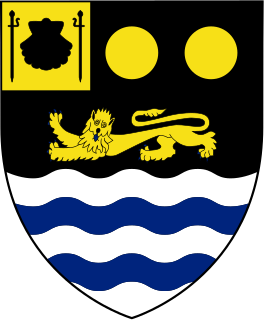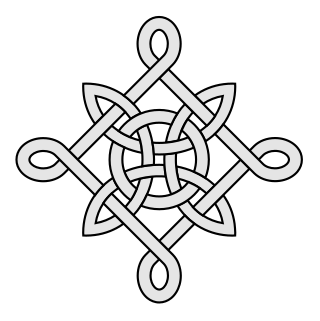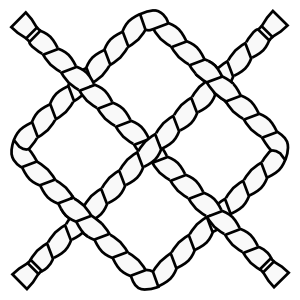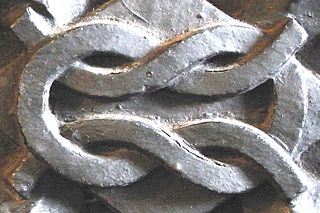
The overhand knot, also known as a a knot and half knot, is one of the most fundamental knots, and it forms the basis of many others, including the simple noose, overhand loop, angler's loop, reef knot, fisherman's knot, and water knot. The overhand knot is a stopper, especially when used alone, and hence it is very secure, to the point of jamming badly. It should be used if the knot is intended to be permanent. It is often used to prevent the end of a rope from unraveling. An overhand knot becomes a trefoil knot, a true knot in the mathematical sense, by joining the ends.

The granny knot is a binding knot, used to secure a rope or line around an object. It is considered inferior to the reef knot, which it superficially resembles. Neither of these knots should be used as a bend knot for attaching two ropes together.
The granny knot is also called the false, lubber's, calf, and booby knot. Patterson's Nautical Encyclopedia calls it "old granny knot" and Sir Edwin Arnold calls it the "common or garden knot." The name granny is given in Vocabulary of Sea Phrases and Roding pictures the knot in 1795.
The granny consists of two identical half knots, one tied on top of the other. It has but one practical purpose that I know of and that is to serve as a surgeon's knot. Formerly it was employed for tying up parcels in five-and-ten-cent stores, but the practice was given up and paper bags substituted as they were found to be simpler.

The Savoy knot, a type of decorative knot, is a heraldic knot used primarily in Italian heraldry. It is most notable for its appearance on the heraldic badge of the House of Savoy, where it is accompanied by the motto Stringe ma non costringe, "It tightens, but does not constrain". The Cavendish knot is an identical heraldic knot. In shape, the Savoy knot is comparable to a figure eight.

The Tudor rose is the traditional floral heraldic emblem of England and takes its name and origins from the House of Tudor, which united the House of Lancaster and the House of York. The Tudor rose consists of five white inner petals, representing the House of York, and five red outer petals to represent the House of Lancaster.

A heraldic badge, emblem, impresa, device, or personal device worn as a badge indicates allegiance to, or the property of, an individual or family. Medieval forms are usually called a livery badge, and also a cognizance. They are para-heraldic, not necessarily using elements from the coat of arms of the person or family they represent, though many do, often taking the crest or supporters. Their use was more flexible than that of arms proper.
The Stafford knot, more commonly known as the Staffordshire knot, is a distinctive three-looped knot that is the traditional symbol of the English county of Staffordshire and of its county town, Stafford. It is a particular representation of the simple overhand knot, the most basic knot of all.

The pilgrim's staff is a walking stick used by pilgrims during their pilgrimages, like the Way of St. James to the shrine of Santiago de Compostela in Spain or the Via Francigena to Rome. In Rome, in the middle ages the pilgrims used to leave their stick in the church of San Giacomo Scossacavalli, whose first denomination was San Salvatore de Bordonia, where Bordone is the Italian word for Stick. After that, they bought a new stick by sellers named Vergari, whose shops where in today's Borgo Santo Spirito near the church of Santa Maria dei Vergari.

An Alphyn, also known as awfyn or alfin in older writings, is a rare heraldic creature. It is much like a heraldic tyger, but stockier and with tufts of hair covering its body, and also has a thick mane and long thin tongue. Another notable characteristic is its knotted tail, reminiscent of Celtic design and similar to that of the griffin. Sometimes it is depicted as having an eagle's or dragon's talons on its forelegs, other times they are cloven, like a goat's. Occasionally all four feet are depicted as having the claws of a lion. In English heraldry, the Alphyn was used as a heraldic badge of the Lords de la Warr, and also appeared on the guidon held by the knight in the Milleflour Tapestry in Somerset.

A heraldic knot is a knot, unknot, or design incorporating a knot used in European heraldry. While a given knot can be used on more than one family's achievement of arms, the family on whose coat the knot originated usually gives its name to the said knot. These knots can be used to charge shields and crests, but can also be used in badges or as standalone symbols of the families for whom they are named. The simplest of these patterns, the Bowen knot, is often referred to as the heraldic knot in symbolism and art outside of heraldry.
The Shakespeare knot, a type of decorative unknot, is a heraldic knot. It is a derivative of the Bowen knot and closely akin to the Dacre knot. The knot is most notable for its appearance on the Shakespeare badge.

The Wake knot or Ormond knot is an English heraldic knot used historically as an heraldic badge by the Wake family, lords of the manor of Bourne in Lincolnshire and also by the Butler family, Earls of Ormond.

The Hungerford or Hastings knot is a heraldic knot used as an heraldic badge in English heraldry by the Hungerford and Hastings families. The binding together of a Hungerford sickle and a Peverell garb (wheatsheaf) with the Hungerford knot commemorates the marriage between the Hungerfords and the Peverells in the early 15th century.
The Dacre knot, a type of decorative unknot, is a heraldic knot used primarily in English heraldry. It is most notable for its appearance on the Dacre family heraldic badge, where its two lower dexter loops entwine a scallop, and its two lower sinister loops entwine a log.

The royal standards of England were narrow, tapering swallow-tailed heraldic flags, of considerable length, used mainly for mustering troops in battle, in pageants and at funerals, by the monarchs of England. In high favour during the Tudor period, the Royal English Standard was a flag that was of a separate design and purpose to the Royal Banner. It featured St George's Cross at its head, followed by a number of heraldic devices, a supporter, badges or crests, with a motto—but it did not bear a coat of arms. The Royal Standard changed its composition frequently from reign to reign, but retained the motto Dieu et mon droit, meaning God and my right; which was divided into two bands: Dieu et mon and Droyt.

A cross potent, also known as a crutch cross, is a form of heraldic cross with crossbars at the four ends. In French, it is known as croix potencée, in German as a Kruckenkreuz, all translating to "crutch cross", but more familiarly called a swastika.

The Heneage knot is a decorative heraldic knot, the badge of the Heneage family of Lincolnshire, England. It was awarded to Sir Thomas Heneage by Queen Elizabeth I in 1594.

The Lacy or de Lacy knot is a decorative heraldic knot, the badge of the de Lacy family. It features in the crest of the borough of Burnley and heraldic badge of Kirklees.

The Harrington knot is a decorative heraldic knot, the badge of the Harrington family. It is in essence identical to the fret.

The Bourchier knot is a variety of heraldic knot. It was used as a heraldic badge by the Bourchier family, whose earliest prominent ancestor in England was John de Bourchier, a Judge of the Common Pleas, seated at Stanstead Hall in the parish of Halstead, Essex. He was the father of Robert Bourchier, 1st Baron Bourchier (d.1349), Lord Chancellor of England. The various branches of his descendants held the titles Baron Bourchier, Count of Eu, Viscount Bourchier, Earl of Essex, Baron Berners, Baron FitzWarin and Earl of Bath. The knot should perhaps have been called the "FitzWarin knot" as according to Boutell (1864) the device was first used by the FitzWarin family, whose heir was the Bourchier family.



















